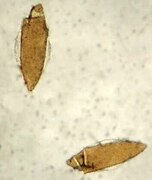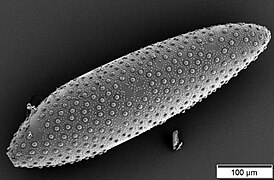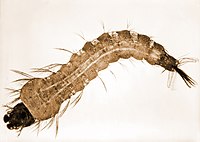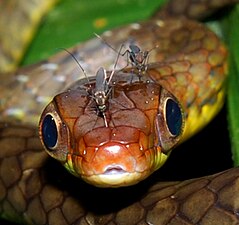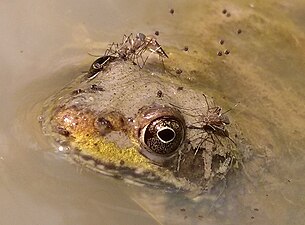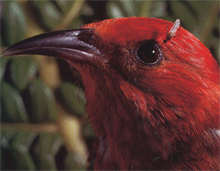Mosquito
| Mosquito Temporal range: Early Cretaceous (Barremian) – Recent
| |
|---|---|

| |
| Aedes aegypti | |
| Scientific classification | |
| Domain: | Eukaryota |
| Kingdom: | Animalia |
| Phylum: | Arthropoda |
| Class: | Insecta |
| Order: | Diptera |
| Superfamily: | Culicoidea |
| Family: | Culicidae Meigen, 1818[1] |
| Subfamilies | |
| Diversity | |
| 112 genera | |
Mosquitoes, the Culicidae, are a
The mosquito life cycle consists of four stages:
The mosquito's
Description and life cycle

Like all flies, mosquitoes go through four stages in their life cycles:
Adult
Mosquitoes have one pair of wings, with distinct scales on the surface. Their wings are long and narrow, while the legs are long and thin. The body, usually grey or black, is slender, and typically 3–6 mm long. When at rest, mosquitoes hold their first pair of legs outwards, whereas the somewhat similar
Mosquitoes can develop from egg to adult in hot weather in as few as five days, but it may take up to a month.
-
Anatomy of an adult female mosquito
-
Adult yellow fever mosquito Aedes aegypti, typical of subfamily Culicinae. Male (left) has bushy antennae and longer palps than female (right)
Eggs
The eggs of most mosquitoes are laid in stagnant water, which may be a pond, a marsh, a temporary puddle, a water-filled hole in a tree, or the water-trapping leaf axils of a bromeliad. Some lay near the water's edge while others attach their eggs to aquatic plants. A few, like Opifex fuscus, can breed in salt-marshes.[5] Wyeomyia smithii breeds in the pitchers of pitcher plants, its larvae feeding on decaying insects that have drowned there.[18]
Clutches of eggs of most mosquito species hatch simultaneously, but Aedes eggs in diapause hatch irregularly over an extended period.[19]
-
Anopheles eggs with side floats
-
Electron micrograph of a culicine egg
-
Culex egg raft
Larva
The mosquito larva's head has prominent mouth brushes used for feeding, a large
Pupa
The head and thorax of the pupa are merged into a cephalothorax, with the abdomen curving around beneath it. The pupa or "tumbler" can swim actively by flipping its abdomen. Like the larva, the pupa of most species must come to the surface frequently to breathe, which they do through a pair of respiratory trumpets on their cephalothoraxes. They do not feed; they pass much of their time hanging from the surface of the water by their respiratory trumpets. If alarmed, they swim downwards by flipping their abdomens in much the same way as the larvae. If undisturbed, they soon float up again. The adult emerges from the pupa at the surface of the water and flies off.[13]
-
Mosquito pupae, shortly before the adults emerged. The head and thorax are fused into the cephalothorax.
Feeding by adults
Diet

Both male and female mosquitoes feed on
Host animals
Blood-sucking mosquitoes favour particular host species, though they are less selective when food is short. Different mosquito species favor
-
Feeding on a snake
-
Feeding on a frog
-
Feeding on a bird
Finding hosts
Most mosquito species are
Mouthparts
Female mosquito mouthparts are highly adapted to piercing skin and sucking blood. Males only drink sugary fluids, and have less specialized mouthparts.[41]
Externally, the most obvious feeding structure of the mosquito is the proboscis, composed of the
-
Evolution of mosquito mouthparts, with grasshopper mouthparts (shown both in situ and separately) representing a more primitive condition. All the mouthparts except the labium are stylets, formed into a fascicle or bundle.
-
Mouthparts of a female mosquito while feeding on blood, showing the flexiblelabiumsheath supporting the piercing and sucking tube which penetrates the host's skin
Saliva
Mosquito saliva contains
For a mosquito to obtain a blood meal, it must circumvent its
Egg development and blood digestion
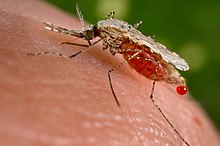
Females of many blood-feeding species need a blood meal to begin the process of egg development. A sufficiently large blood meal triggers a hormonal cascade that leads to egg development.[58] Upon completion of feeding, the mosquito withdraws her proboscis, and as the gut fills up, the stomach lining secretes a peritrophic membrane that surrounds the blood. This keeps the blood separate from anything else in the stomach. Like many Hemiptera that survive on dilute liquid diets, many adult mosquitoes excrete surplus liquid even when feeding. This permits females to accumulate a full meal of nutrient solids. The blood meal is digested over a period of several days.[59] Once blood is in the stomach, the midgut synthesizes protease enzymes, primarily trypsin assisted by aminopeptidase, that hydrolyze the blood proteins into free amino acids. These are used in the synthesis of vitellogenin, which in turn is made into egg yolk protein.[60]
Ecology and distribution
Distribution
Mosquitoes have a
Eggs of
For a mosquito to transmit disease, there must be favorable seasonal conditions,
Predators and parasites
Mosquito larvae are among the commonest animals in ponds, and they form an important food source for freshwater
Emerging adults are consumed at the pond surface by predatory flies including Empididae and Dolichopodidae, and by spiders. Flying adults are captured by dragonflies and damselflies, by birds such as swifts and swallows, and by vertebrates including bats.[75]
Mosquitoes are parasitised by hydrachnid mites, ciliates such as Glaucoma, microsporidians such as Thelania, and fungi including species of Saprolegniaceae and Entomophthoraceae.[75]
Pollination

Several flowers including members of the
Parasitism
Ecologically, blood-feeding mosquitoes are
Evolution
Fossil record

The oldest known mosquitoes are
Taxonomy
Over 3,600 species of mosquitoes in 112
The name Culicidae was introduced by the German entomologist
Phylogeny
External
Mosquitoes are members of a family of true flies (Diptera): the Culicidae (from the Latin culex, genitive culicis, meaning "midge" or "gnat").[89] The phylogenetic tree is based on the FLYTREE project.[90][91]
Diptera
|
| ||||||||||||||||||||||||||||||||||||||||||||||||
| (true flies) |
Internal
Kyanne Reidenbach and colleagues analysed mosquito phylogenetics in 2009, using both nuclear DNA and morphology of 26 species. They note that Anophelinae is confirmed to be rather basal, but that the deeper parts of the tree are not well resolved.[92]
Interactions with humans
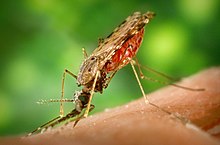
Vectors of disease
Mosquitoes are
Control

Many measures have been tried for
Repellents

Insect repellents are applied on skin and give short-term protection against mosquito bites. The chemical
Bites
Mosquito bites lead to a variety of skin reactions and more seriously to
In human culture
Greek mythology
Origin myths
The peoples of
Lafcadio Hearn tells that in Japan, mosquitoes are seen as reincarnations of the dead, condemned by the errors of their former lives to the condition of Jiki-ketsu-gaki, or "blood-drinking pretas".[126]
Modern era
Winsor McCay's 1912 film How a Mosquito Operates was one of the earliest works of animation. It has been described as far ahead of its time in technical quality.[127] It depicts a giant mosquito tormenting a sleeping man.[128]
Twelve ships of the Royal Navy have borne the name HMS Mosquito or the archaic form of the name, HMS Musquito.[129]
The de Havilland Mosquito was a high-speed aircraft manufactured between 1940 and 1950, and used in many roles.[130]
References
- ^ Harbach, Ralph (2 November 2008). "Family Culicidae Meigen, 1818". Mosquito Taxonomic Inventory. Archived from the original on 3 October 2022. Retrieved 15 March 2022., see also Valid Species List Archived 2022-03-15 at the Wayback Machine
- Real Academia Española. Archivedfrom the original on 24 July 2016. Retrieved 24 July 2016.
- ISBN 978-0-19-861271-1.
- ^ "FAQs". AMCA. Archived from the original on 16 July 2019.
- ^ from the original on 24 June 2014. Retrieved 1 April 2013.
- ^ Kosova, Jonida (2003) "Longevity Studies of Sindbis Virus Infected Aedes Albopictus" Archived 2012-04-25 at the Wayback Machine. All Volumes (2001–2008). Paper 94.
- ^ "Midges". MDC Discover Nature. Archived from the original on 26 October 2019. Retrieved 19 November 2019.
- PMID 15266751. Archived from the original(PDF) on 28 July 2011.
- ^ Leung, Diana (2000). Elert, Glenn (ed.). "Frequency of mosquito wings". The Physics Factbook. Archived from the original on 25 January 2022. Retrieved 24 January 2022.
- PMID 14327957.
- ISBN 978-1-4160-4470-3.
- ^ "African malaria mosquito". University of Florida. Retrieved 11 February 2024.
- ^ Environmental Protection Agency. 21 February 2013. Retrieved 12 December 2023.
- ^ a b c d "Anopheles Mosquitoes". Centers for Disease Control and Prevention. 16 July 2020. Retrieved 13 December 2023.
- ^ "Male mosquito odours reveal how mozzies mate". WITS. University of Witwatersrand, Johannesburg. 5 August 2020.
- S2CID 220948478.
- ^ .
- ^ Crans, Wayne J.; Wyeomyia smithii (Coquillett) Archived 2013-06-05 at the Wayback Machine. Rutgers University, Center for Vector Biology.
- ^ PMID 17038186.
- ISBN 978-1-118-84616-2.
- ISBN 978-0-7868-6781-3.
- PMID 35043213.
- PMID 30846726.
- ISBN 978-93-87741-30-0. Archivedfrom the original on 29 January 2022. Retrieved 6 April 2021.
Only female mosquitoes require a blood meal (protein)...The number of egg formation and development in ovary of the female is directly dependent on quantum and nature supply of blood meal.
- ^ "Biology". mosquito.org. American Mosquito Control Association. Archived from the original on 29 March 2021. Retrieved 6 April 2021.
Acquiring a blood meal (protein) is essential for egg production, but mostly both male and female mosquitoes are nectar feeders for their nutrition.
- PMID 11004785.
- ISBN 978-0-521-83608-1. Archivedfrom the original on 28 May 2016. Retrieved 18 February 2016.
- LSU AgCenter. 9 September 2020. Archivedfrom the original on 26 February 2022. Retrieved 26 February 2022.
- PMID 25372720.
- PMID 21991329.
- ^ Crans, Wayne J. (1989). Resting boxes as mosquito surveillance tools. Proceedings of the Eighty-Second Annual Meeting of the New Jersey Mosquito Control Association. pp. 53–57. Archived from the original on 20 July 2006.
- ^ Maruniak, James E. (July 2014). "Asian tiger mosquito". Featured Creatures. Gainesville, Florida: University of Florida. Archived from the original on 7 September 2014. Retrieved 2 October 2014.
- S2CID 4419658.
- US News. 28 October 2009.
- Richard Dawkins Foundation. 21 November 2014. Archivedfrom the original on 25 November 2014. Retrieved 21 November 2014.
- ^ Devlin, Hannah (4 February 2010). "Sweat and blood why mosquitoes pick and choose between humans". The Times. London. Archived from the original on 3 October 2022. Retrieved 13 May 2010.
- ^ Estrada-Franco, R. G.; Craig, G. B. (1995). Biology, disease relationship and control of Aedes albopictus. Technical Paper No. 42. Washington, D.C.: Pan American Health Organization.
- PMID 15311477.
- ^ Chappell, Bill (12 July 2013). "5 Stars: A Mosquito's Idea Of A Delicious Human". NPR. Archived from the original on 14 October 2014. Retrieved 23 July 2021.
- PMID 25901606.
- S2CID 41524028.
- ^ Quirós, Gabriela (7 June 2016). "WATCH: Mosquitoes Use 6 Needles To Suck Your Blood". NPR. Retrieved 13 December 2023.
- PMID 26578978.
- PMID 36284127.
- S2CID 13019630.
- PMID 3519067.
- ^ PMID 12213246.
- from the original on 4 August 2020. Retrieved 29 June 2019.
- PMID 7679483.
- PMID 7985763.
- from the original on 10 April 2022. Retrieved 25 September 2020.
- S2CID 42458052.
- S2CID 32742815.
- PMID 16547250.
- PMID 15671753.
- PMID 6255036.
- PMID 29771921.
- PMID 15455051.
- PMID 24315597.
- PMID 1770523.
- ^ "Vísindavefurinn: Af hverju lifa ekki moskítóflugur á Íslandi, fyrst þær geta lifað báðum megin á Grænlandi?" (in Icelandic). Visindavefur.hi.is. Archived from the original on 2 August 2013. Retrieved 15 October 2013.
- S2CID 86752961.
- .
- PMID 2709388.
- PMID 7473614.
- S2CID 41129725.
- PMID 20651669.
- PMID 11250812– via EHP.
- PMID 23497420.
- PMID 30120891.
- PMID 29229233.
- PMID 29219091.
- PMID 29219091.
- ^ Beck, Kevin (22 November 2019). "What Eats Mosquitoes?". Sciencing. Archived from the original on 2 June 2021. Retrieved 31 May 2021.
- ^ a b Medlock, J. M.; Snow, K. R. (2008). "Natural predators and parasites of British mosquitoes–a review" (PDF). European Mosquito Bulletin. 25 (1): 1–11.
- ISBN 978-0-87140-480-0.
Parasites, in a phrase, are predators that eat prey in units of less than one. Tolerable parasites are those that have evolved to ensure their own survival and reproduction but at the same time with minimum pain and cost to the host.
- PMID 21295676.
- ^ PMID 24229807.

- ISSN 2356-6582.
- S2CID 265612144.
- .
- ^ S2CID 92836430.
- ^ Poinar, G. O.; et al. (2000). "Paleoculicis minutus (Diptera: Culicidae) n. gen., n. sp., from Cretaceous Canadian amber with a summary of described fossil mosquitoes" (PDF). Acta Geológica Hispánica. 35: 119–128. Archived from the original (PDF) on 29 October 2013. Retrieved 10 December 2009.
- S2CID 236612378.
- PMID 24140295.
- ^ Meigen, Johann Wilhelm (1818–1838). Systematische Beschreibung der bekannten Europäischen zweiflügeligen Insekten [Systematic description of the known European two-winged insects] (in German). Vol. 1–7. Aachen: Friedrich Wilhelm Forstmann.
- ISBN 978-1178519037.
- S2CID 46364692.
- ISBN 978-0-398-06179-1.
- ^ Yeates, David K.; Meier, Rudolf; Wiegmann, Brian. "Phylogeny of True Flies (Diptera): A 250 Million Year Old Success Story in Terrestrial Diversification". Flytree. Illinois Natural History Survey. Archived from the original on 28 December 2015. Retrieved 24 May 2016.
- .
- PMID 20028549.
- ^ "Mosquito as Deadly Menace". Pfizer.
- ^ "Yellow fever Fact sheet N°100". World Health Organization. May 2013. Archived from the original on 19 February 2014. Retrieved 23 February 2014.
- ISBN 978-92-4-154787-1. Archived(PDF) from the original on 17 October 2012. Retrieved 13 August 2013.
- ^ "Lymphatic Filariasis". World Health Organisation. Archived from the original on 5 May 2016. Retrieved 24 August 2011.
- PMID 21776596.
- ^ "Fungus Fatal to Mosquito May Aid Global War on Malaria". The New York Times. 10 June 2005. Archived from the original on 9 May 2015. Retrieved 19 February 2017.
- .
- PMID 2570111.
- JSTOR 1948627.
- ISBN 978-1-55250-313-3. Archived from the originalon 9 June 2011.
- S2CID 35046348.
- S2CID 7645668.
- S2CID 26987818.
- ^ Carpenter, Jennifer (8 August 2011). "Spermless mosquitoes hold promise to stop malaria". BBC. Archived from the original on 9 August 2011. Retrieved 5 August 2011.
Scientists have created spermless mosquitoes in an effort to curb the spread of malaria.
- ^ Webb, Jonathan (10 June 2014) GM lab mosquitoes may aid malaria fight Archived 2022-08-16 at the Wayback Machine. BBC.
- (PDF) from the original on 29 April 2019. Retrieved 23 September 2019.
- ^ Michael Le Page (29 September 2018). "Gene tool could halt malaria spread". New Scientist. Archived from the original on 12 November 2018. Retrieved 2 November 2018.
- PMID 18711137.
- ^ "Updated Information regarding Insect Repellents". Centers for Disease Control and Prevention. 2009. Archived from the original on 12 May 2013. Retrieved 10 September 2017.
- ^ Nuwer, Rachel, Natural Mosquito Repellent's Powers Finally Decoded Archived 2021-08-12 at the Wayback Machine, Scientific American 325, 2, 23 (August 2021)
- ^ "Electronic mosquito repellents for preventing mosquito bites and malaria infection" (PDF). Archived (PDF) from the original on 8 August 2017. Retrieved 19 September 2018.
- S2CID 35297787.
- PMID 24364549.
- PMID 27177994.
- S2CID 45260523.
- PMID 17169531.
- PMID 23352522.
- PMID 23442453.
- PMID 9689301.
- PMID 22253544.
- ^ "Treatment of Insect bites and stings". nhs.uk. 19 October 2017. Archived from the original on 31 October 2018. Retrieved 31 October 2018.
- ISBN 978-90-04-11454-8. Archivedfrom the original on 28 May 2016. Retrieved 18 February 2016.
- Holmberg, Uno (1927), "Finno-Ugric and Siberian", The Mythology of All Races, vol. 4, Boston, Marshall Jones Company, IX. "The Origin of the Mosquito", p.386
- ISBN 978-1420967517.
- ISBN 978-0-240-81218-2. Archivedfrom the original on 4 November 2021. Retrieved 4 September 2022.
- ISBN 978-0-8109-5941-5.
- ISBN 978-1-86176-281-8., "Mosquito" and "Musquito".
- ^ "De Havilland Mosquito". The Aviation History Online Museum. Archived from the original on 11 January 2017. Retrieved 21 November 2015.
Further reading
- Winegard, Timothy Charles (2019). The mosquito: a human history of our deadliest predator. Penguin Random House. OCLC 1111638283.
External links
- Mosquito at IFAS
- A film clip describing The Life Cycle of the Mosquito is available for viewing at the Internet Archive
- Parasitic Insects, Mites and Ticks: Genera of Medical and Veterinary Importance Wikibooks



